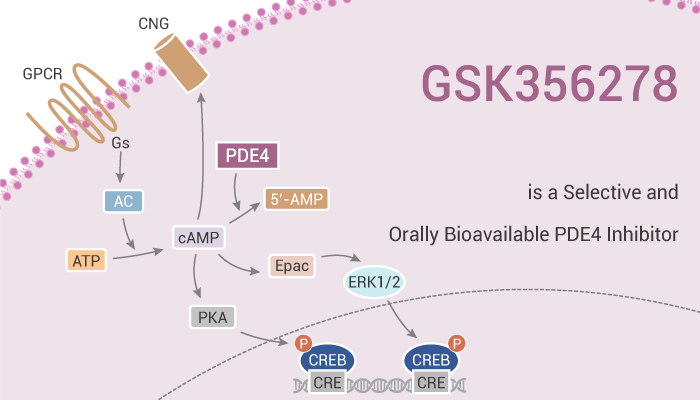Phosphodiesterase-4 (PDE4) acts as an intracellular non-receptor enzyme that modulates inflammation and epithelial integrity. GSK356278, a potent, selective, brain-penetrant phosphodiesterase 4 ( PDE4) inhibitor that demonstrates anxiolytic and cognition-enhancing effects without inducing side effects in preclinical species.

GSK356278 inhibits PDE4B enzyme activity with a pIC50 of 8.8 and binds to the high-affinity Rolipram binding site with a pIC50 of 8.6. Moreover, GSK356278 inhibits the hydrolytic enzyme activity of recombinant PDE4B with the same potency as it binds to the high-affinity Rolipram binding site (HARBS). Especially, GSK356278 is a potent inhibitor of the cAMP hydrolytic activity of PDE4B, with a pIC50 of 8.8.
GSK356278 competes with [3H]Rolipram for the HARBS with a similar affinity, yielding a pKi of 8.6. GSK356278 inhibits PDE4A, PDE4B, and PDE4D equally with pIC50 values of 8.6, 8.8, and 8.7, respectively. In particular, GSK356278 binds to the HARBS in rats, mice, marmosets, and ferrets with pKi values of 7.9, 7.8, 8.4, and 8.5, respectively. GSK356278 inhibits TNF-α release with a pIC50 of 7.6, similar to the potency of 7.7 for Roflumilast. In addition, SK356278 shows a competitive time-independent mode of action at the recombinant PDE4B enzyme. GSK356278 has a faster dissociation rate from marmoset native PDE4 HARBS versus Rolipram.
All in all, GSK356278 is an orally bioavailable, brain-penetrant, and low-clearance PDE4 inhibitor in multiple preclinical species. GSK356278 shows anti-inflammatory activity in rodents at exposures that do not induce pica feeding. Furthermore, GSK356278 demonstrates efficacy in a non-human primate model of anxiety at exposures that do not induce emesis. GSK356278 enhances performance in a test of executive function.